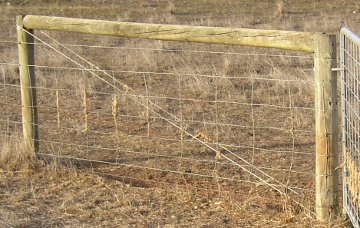
Cleanskin
Sheep
Information
Fencing for Shedding Sheep
Most new farmers find quickly that they need to spend money on fencing, either for repairs or for smaller
paddocks. Dividing up the paddocks allows rotational grazing, which benefits any pasture and can be necessary to allow perennial pasture to survive. New water points may be
needed for the new paddocks. Fix the fencing before you get the sheep, and remember that it must keep your neighbours' stock out, as well as keeping your own sheep in - a
problem if they run goats or deer! Here are the basics:
Strainer assemblies:
Old fences have a massive post in the corner, and intermediate posts at about four metre intervals. Strainer
assemblies (box strainers) revolutionised fencing by providing a stronger corner with two posts, a top rail post between them, and a wire diagonal from the bottom of the post
in the corner to the top of the other post. The intermediate posts can be at ten or even twenty metre intervals, with above-ground 'spacers' every few metres.

Double Box Strainer
Posts:
Posts and their spacing (and sometimes other fencing choices) depend on the terrain. Check the Internet for
more information about your type of land.
*
Timber posts are usually 'green' CCA pressure treated, or creosote treated, to stop them rotting below ground. Each treatment has some health
and handling disadvantages. If you cut posts from your own trees, creosote is probably the best treatment option. Posts should be in the ground for a third of their total
length. The hole is drilled with an auger (machine or manual). The posts are put in by a post ramming machine, or manually by packing earth or rocks around them, then ramming
with a crow bar.
*
Concrete posts can't be rammed by machine, so when the hole is drilled they must be put in manually. You can buy concrete posts, or buy a mould
and make your own.
*
Star posts (star pickets/ droppers) are three- cornered metal posts. They are usually put straight into the ground with a sledge hammer or a
manual 'dropper knocker'.
*
Spacers (don't confuse these with star 'dropper' posts) are metal, plastic or wooden, and are attached to the fence wires above-ground to keep
the wires at the right spacings.
Electric fencing:
*
Electric fencing is lighter, cheaper and easier to put up. It works better with cleanskin sheep than with wool sheep, and solar power can make
it convenient. But...
*
It stops you from climbing through your own fences. Electric shocks are nasty, particularly for children.
*
In very dry ground, it may not work - the electric current needs to return through earth with some moisture. With good rain, any grass that
grows high and touches the wire can short out the current. Posts and wire can be knocked down by kangaroos. For all these reasons, electric fences need regular checking.
Wire:
*
Plain wire strands, with or without electric strands, make the cheapest fence. However it needs very good tensioning, and still may not hold
lambs or some adult sheep.
*
Sheep mesh comes in squares/ rectangles of horizontal and vertical wires, with several spacing options. Sheep-and-lamb mesh has closer
horizontals on the bottom to hold the lambs. It is often preferred to electric fencing, in spite of its higher cost.
*
Barbed wire is expensive, hard to handle and uncomfortable to climb through. A bottom row of barb, under sheep and lamb mesh, can be useful to
deter sheep from pushing the wires up. It also keeps the bottom wire of mesh off the ground and less likely to rust. A top row of barb is nasty for humans, and can damage
the udder or balls of champion hurdler sheep. It may be useful for road fencing to discourage trespassers.
*
All wire must be strained, usually with a wire strainer. Sheep can push slack wire up or down, so the tension must be good. A wire tension gauge
is a helpful extra.

CCA posts, sheep & lamb mesh, barb underwire, plain top wire.